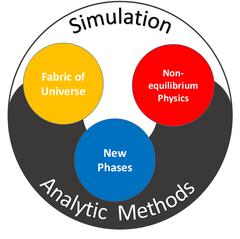Research
Founding members of the WPC are spread over 12 different institutions (on and off campus). The major research areas in theoretical physics in Hamburg and Zeuthen
- particle physics
- astrophysics & cosmology
- mathematical physics
- condensed matter
- ultracold atoms
- ultrafast processes
are re-organized into five highly intersectional scientific pillars devoted to
- New Phases and Phase Transitions
- Nonequilibrium Physics
- Fabric of Space-time and Matter
- Analytical Methods
- Simulation and Numerical Techniques
The five scientific pillars of the WPC cover the most exciting areas of theoretical physics today. The boundaries between them are a bit fuzzy and put together activities that are a priori quite different.
The two pillars "New Phases and Phase Transitions" and "Nonequilibrium Physics" touch directly the topics of the CUI: Advanced Imaging of Matter (AIM) cluster of excellence while the pillar "Fabric of Spacetime and Matter" is more concerned with the Quantum Universe (QU) cluster of excellence. The two pillars "Analytical Methods" and "Simulation and Numerical Techniques" gather tools and techniques that are relevant for the research domains outlined in the first three pillars.
This organisation of the WPC is meant to strengthen opportunities for exchange of ideas and interdisciplinary research, fulfilling the goals of WPC.


